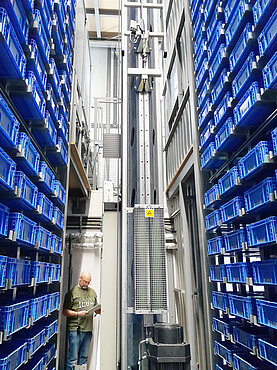For more than 75 years, the SPINNER Group has been setting standards in high-frequency technology with its products. With headquarters in Munich and production facilities in Germany, Hungary and China, the SPINNER Group employs more than 800 people worldwide. The online store offers a wide range of products from connectors and hybrid rotary joints to tools required in high-frequency technology.
Extending the service life
The logistics facility in Westerham near Munich, which dated back to 2002, was to be brought up to the latest state of the art. Some spare parts were barely available, components, software and safety technology were getting on in years and no longer met current standards. The risk of longer downtimes was foreseeable. The retrofit comprised a two-aisle, four-deep, automated small parts warehouse with two storage and retrieval machines for plastic containers and a pre-zone conveyor system with a connection to incoming goods, outgoing goods and order picking. The automated small parts warehouse is the central hub that connects two production halls via a conveyor bridge and three floors. "Even older logistics systems often function in practice for well over 20 years. For the retrofit to succeed, experienced logistics experts and a detailed retrofit concept are required in order to be able to precisely assess the time and technical risks," explains Hagen Schumann, Managing Director of Klinkhammer Intralogistics GmbH
Inventory of system-critical products
Klinkhammer carried out an intensive inventory in advance to identify system-critical products that could have an impact on the ongoing operation of the plant. A retrofit concept specially developed for the SPINNER Group was then created to ensure reliable operation of the system and a smooth process that minimized interference with ongoing production operations as far as possible. During the retrofit, mechanical, electrical and PLC components of the logistics system were replaced in order to bring the system up to the current state of the art. The replacement of the control technology not only included technical components, but also the PLC programming. The traveling control cabinet on the storage and retrieval crane was completely replaced so that spare parts are available when needed. By replacing the travel and hoist motors of the container storage and retrieval cranes and their load handling devices with telescopic and belt drives, a homogeneous drive landscape was created for the new generation of inverters. The sensors for path detection and safety-relevant devices outside the control cabinet were also replaced so that the devices have the functions required by the current Machinery Directive. The cables in the drag chains were replaced as a precautionary measure due to the long service life in order to guarantee the system's reliability.
Software, an important component
When the control technology was replaced, the latest version of the KlinkVISION system visualization was installed in order to identify the cause of faults more quickly in future and to be able to eliminate them via remote diagnostics. With KlinkVISION, the system operator can call up the exact location data and target data of each loading unit and carry out a quick alarm diagnosis in the warehouse. Klinkhammer also offers long-term service and hotline concepts for the system's software and hardware to ensure reliable operation. The interface between the new control technology and the material flow control system has also been optimized in terms of software. In a second step, the warehouse management system will be migrated to a new software version, as this will no longer be updateable in the medium term. Nowadays, the software is an important component of every system that maps the business processes and controls the logistical processes with regard to order, inventory and storage location management.
"Good preparation and structuring of the planning pays off," adds Harald Dirnaichner, Project Manager Logistics at SPINNER GmbH. "Thanks to the overall good mechanical condition and careful maintenance by Klinkhammer, we opted for a retrofit based on a comprehensive analysis. This enabled us to implement a future-proof warehouse modernization that saved us from having to invest in a new logistics system."
Overall, the modernization at SPINNER shows that even older logistics systems can be made fit for the future through targeted actions and competent partners. This not only saves costs, but also ensures operational reliability and efficiency for years to come. The SPINNER Group can therefore continue to focus on its core competencies and further expand its position in the field of high-frequency technology.







